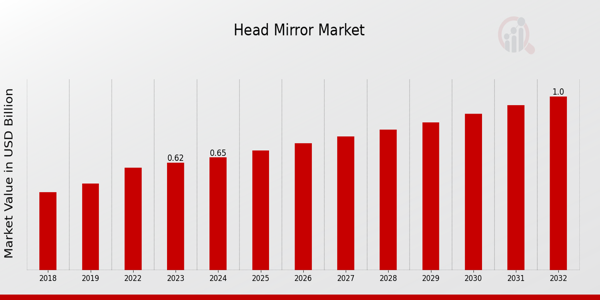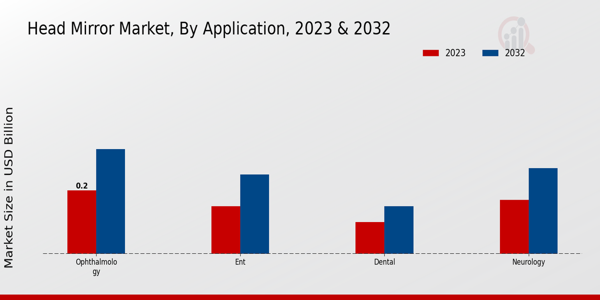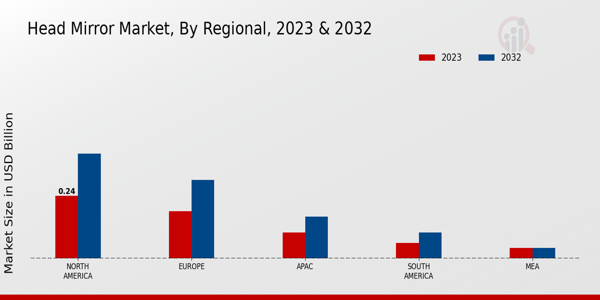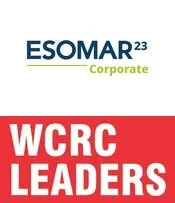Head Mirror Market Overview
As per MRFR analysis, the Head Mirror Market Size was estimated at 0.69 (USD Billion) in 2024. The Head Mirror Market Industry is expected to grow from 0.73 (USD Billion) in 2025 to 1.18 (USD Billion) till 2034, at a CAGR (growth rate) is expected to be around 5.48% during the forecast period (2025 - 2034).
Key Head Mirror Market Trends Highlighted
The Head Mirror Market is driven by several key factors, including the increasing prevalence of various medical conditions requiring effective diagnostic tools. The rising emphasis on precise and early diagnosis in healthcare has also enhanced the demand for head mirrors among medical professionals. Technological advancements that improve the design and functionality of these instruments contribute to market growth. Additionally, the expanding healthcare infrastructure, particularly in emerging economies, plays a significant role in the market's expansion as more healthcare providers seek reliable diagnostic solutions. Opportunities within the market are abundant, especially in untapped regions where healthcare services are evolving.
Growing awareness of the importance of early detection and diagnosis opens doors for introducing innovative products. Investment in research and development can lead to better product offerings, enhancing user experience and accuracy in diagnostics. Furthermore, partnering with healthcare institutions can facilitate the wider adoption of head mirrors, providing opportunities for manufacturers to increase their market presence. Recent trends indicate a shift towards more compact and user-friendly designs in head mirrors. The integration of digital technology into traditional instruments is gaining traction, making diagnostics more efficient and accurate.
There is also a noticeable increase in demand for multi-functional head mirrors that offer additional features, catering to a broader range of medical needs. Sustainability is becoming a focal point, with the market seeing a rise in interest in environmentally friendly materials and processes. Overall, the Head Mirror Market is characterized by continuous innovation and adaptation to the changing landscape of healthcare, presenting both challenges and opportunities for stakeholders.

Source: Primary Research, Secondary Research, MRFR Database and Analyst Review
Head Mirror Market Drivers
Increase in Healthcare Expenditure
The Head Mirror Market Industry is experiencing significant growth due to the rising healthcare expenditure across various countries. As nations focus on improving their healthcare systems, they are investing substantially in medical equipment and diagnostic tools. Head mirrors are essential instruments used in otolaryngology for comprehensive examinations, and their adoption is closely linked to the financial health of healthcare facilities.
As budgets increase, hospitals and clinics are more likely to update their equipment and acquire new technological solutions to enhance patient care. This trend ensures that healthcare professionals are equipped with the necessary tools for accurate diagnosis and effective treatment. Such investments not only improve the quality of healthcare services but also promote better patient outcomes, further driving the demand for head mirrors in the Head Mirror Market Industry.
Additionally, as technology continues to evolve, head mirrors are being designed to be more efficient, user-friendly, and conducive to better medical practices. This push for modernization within healthcare systems encourages the procurement of advanced medical tools, including head mirrors, thus fostering an environment conducive to market growth. Furthermore, with the increasing prevalence of ENT disorders and the corresponding need for precise diagnostic techniques, the demand for head mirrors is likely to rise significantly in the coming years. As a result, healthcare innovation paired with rising expenditure is a key factor propelling the Head Mirror Market towards a positive growth trajectory.
Growing Awareness of ENT Health
As awareness regarding ear, nose, and throat (ENT) health increases among the general public, the demand for diagnostic tools like head mirrors is also on the rise. Educational campaigns and healthcare initiatives aimed at improving knowledge about ENT disorders have made individuals more proactive in seeking medical attention for symptoms. This growing awareness translates to higher utilization of ENT services, thereby encouraging facilities to invest in adequate diagnostic equipment. The Head Mirror Market Industry is benefiting from this heightened interest, leading to an increase in the adoption of head mirrors to conduct thorough examinations and identify ailments early.
Technological Advancements in Diagnostic Equipment
The ongoing technological advancements in diagnostic equipment are significantly influencing the Head Mirror Market Industry. Innovations are leading to improved designs and enhanced functionality of head mirrors, making them more efficient and user-friendly for healthcare professionals. These advancements not only facilitate better accuracy in diagnostics but also enhance patient comfort. As healthcare providers prioritize the implementation of cutting-edge tools, the demand for modernized head mirrors is likely to increase, playing a crucial role in driving the market forward.
Head Mirror Market Segment Insights
Head Mirror Market Application Insights
The Head Mirror Market is significantly driven by its diverse applications across various medical fields, with expected revenue reaching 0.62 billion USD in 2023 and 1.0 billion USD by 2032. This market segmentation reflects the rising need for head mirrors in specialized medical practices, supporting enhanced visibility and precision during examinations. Within this market, the application in Ophthalmology stands out with a valuation of 0.2 billion USD in 2023, projected to grow to 0.33 billion USD by 2032, indicating a growing reliance on head mirrors for eye examinations. This segment holds a significant share as eye care professionals increasingly adopt advanced diagnostic tools to improve patient outcomes.
Meanwhile, the ENT application segment, valued at 0.15 billion USD in 2023, is expected to rise to 0.25 billion USD by 2032. Its importance lies in the necessity for accurate visualization of the ear, nose, and throat during procedures, thereby ensuring better diagnostics and treatment plans. The Dental segment, while smaller, holds a valuation of 0.1 billion USD in 2023, projected to reach 0.15 billion USD in 2032. This segment remains crucial as dentists utilize head mirrors for added clarity during examinations and minor surgical procedures, increasing the demand for such tools, albeit at a comparatively lower scale.
The Neurology application is significant as it commands a value of 0.17 billion USD in 2023, anticipated to expand to 0.27 billion USD by 2032. This segment highlights the essential role head mirrors play in neurological assessments, particularly in examining cranial structures and assessing neurological health. Overall, the Head Mirror Market segmentation demonstrates a strong foundation, with applications in fields such as Ophthalmology and ENT dominating the landscape due to their higher valuations, driven by advancements in technology and an increasing focus on patient care. The combination of market growth and the need for specialized medical tools suggests promising opportunities for further advancements and innovations within the industry. As these sectors continue to evolve, the strategic deployment of head mirrors will likely enhance diagnostic accuracy and patient satisfaction across various medical applications.

Source: Primary Research, Secondary Research, MRFR Database and Analyst Review
Head Mirror Market Material Insights
The Head Mirror Market, valued at 0.62 billion USD in 2023, is witnessing notable growth driven by increasing applications in the medical sector. The Material aspect of this market plays a crucial role, emphasizing the variety of materials used in the production of head mirrors. Stainless Steel, known for its durability and high resistance to corrosion, maintains a significant market presence, catering to hospitals and clinics that prioritize hygiene and longevity. Aluminum is also essential due to its lightweight properties, which facilitate ease of use for healthcare professionals.
Plastic, while gaining traction for its cost-effectiveness and versatility, serves as an alternative option in less critical applications. Glass, traditionally favored for its optical clarity, remains a vital component when precision is required in various medical examinations. Overall, the dynamics of the Head Mirror Market segmentation highlight how each material contributes uniquely to industry growth and adaptation, catering to the specific needs of healthcare settings while addressing broader market trends in safety and efficacy.
Head Mirror Market End Use Insights
The Head Mirror Market focuses on various end-use applications, primarily encompassing hospitals, clinics, and research institutions. In 2023, the overall market was valued at 0.62 USD Billion, reflecting the relevance of head mirrors in medical diagnostics and treatment settings. Hospitals represent a significant portion of this market, as they require high-quality head mirrors for various medical evaluations, thus driving market growth. Clinics also contribute substantially, benefiting from the increasing adoption of advanced diagnostic tools.
Research institutions, on the other hand, enhance the market dynamics through continued exploration and development of medical technology, observing increased utilization of head mirrors for experimental purposes. Overall, as the demand for efficient diagnostic procedures rises, the Head Mirror Market revenue steadily progresses, demonstrating the essential role of these end-use segments in promoting advancements within the healthcare industry and patient care. Enhanced market growth is further propelled by evolving healthcare infrastructure and rising awareness of diagnostic precision, creating numerous opportunities across these sectors.
Head Mirror Market Regional Insights
The Head Mirror Market is expected to experience significant revenue growth across various regions. In 2023, North America leads with a market value of 0.24 USD Billion, projected to reach 0.4 USD Billion by 2032, showcasing its majority holding in the market. Europe follows, valued at 0.18 USD Billion currently and anticipated to rise to 0.3 USD Billion, reflecting its significant role in the market. The Asia-Pacific (APAC) region, while smaller at 0.1 USD Billion in 2023, is set for growth to 0.16 USD Billion, indicating emerging opportunities.
South America and the Middle East Africa (MEA) are valued at 0.06 USD Billion and 0.04 USD Billion, respectively, and are expected to show steady but modest growth. The strong presence in North America and Europe highlights established healthcare infrastructures and a growing demand for head mirror products driven by increased healthcare spending and technological advancements. In contrast, the smaller valuations in APAC, South America, and MEA suggest potential growth drivers, including rising awareness and evolving medical practices. Overall, the regional segmentation indicates varying levels of market growth and opportunities across these key regions in the Head Mirror Market.

Source: Primary Research, Secondary Research, MRFR Database and Analyst Review
Head Mirror Market Key Players and Competitive Insights
The Head Mirror Market is characterized by a competitive landscape where various key players are continually enhancing their products to cater to a diverse range of customer needs. This market is influenced by factors such as technological advancements, regulatory frameworks, and evolving customer preferences. Players within this sector focus on innovation, quality, and providing comprehensive solutions to maintain their competitive edge. As the demand for head mirrors increases in various medical applications, manufacturers are compelled to adopt strategic initiatives, such as collaborations and acquisitions, to strengthen their market positions and expand their geographic reach. Understanding the competitive dynamics and positioning of leading brands is crucial for stakeholders aiming to make informed decisions in this market.
Hoya Corporation holds a significant presence in the Head Mirror Market, leveraging its extensive experience and deep understanding of optical technology. The company focuses on high-quality manufacturing processes, ensuring that its head mirrors can meet the rigorous demands of the medical sector. Hoya Corporation is known for its commitment to innovation, consistently introducing products that enhance visual clarity and patient comfort. With a strong emphasis on research and development, the company stays at the forefront of market trends, allowing it to effectively address the specific requirements of healthcare professionals. Hoya's robust distribution network and strategic partnerships further bolster its capacity to reach a global audience, making it a formidable player in this specialized market.
Keeler Limited is another key entity in the Head Mirror Market, distinguished by its dedication to precision and the reliability of its products. The company has built a solid reputation for manufacturing high-quality head mirrors that are vital for diagnostic purposes across various healthcare settings. Keeler Limited is recognized for its strong commitment to meeting the needs of eye care professionals, continuously refining its offerings to ensure optimal performance and user satisfaction. The company's focus on customer-centric innovations and its ability to adapt to changing market demands allow it to maintain a competitive advantage. Additionally, Keeler Limited's emphasis on quality control and regulatory compliance positions it favorably within the market, ensuring trust among healthcare providers seeking reliable diagnostic tools.
Key Companies in the Head Mirror Market Include
- Hoya Corporation
- Keeler Limited
- Conmed Corporation
- PENTAX Medical
- Medtronic
- Fujifilm
- Karl Storz
- Surgical Science
- Richard Wolf
- Stryker
- Integra LifeSciences
- Braun Melsungen
- Smithand Nephew
- Weck Surgical
- Olympus Corporation
Head Mirror Market Industry Developments
Recent developments in the Head Mirror Market have indicated an upward trend in demand driven by advancements in medical technology and an increase in minimally invasive surgeries. Companies like Hoya Corporation, Keeler Limited, and Medtronic have reported enhanced product lines designed to improve diagnostic capabilities and surgical outcomes. Furthermore, notable collaborations among major players such as Fujifilm, Olympus Corporation, and Karl Storz have been aimed at the development of innovative imaging systems that complement head mirrors.
In terms of mergers and acquisitions, the market witnessed significant activity, though recent news specifically highlights partnerships more than outright acquisitions. Companies are optimizing their portfolios through strategic alliances to expand market share and enhance technological offerings. Growth in market valuation for names like Stryker and Integra LifeSciences has also been observed, emphasizing increased investment in research and development. This positive trajectory is largely attributed to evolving healthcare needs, with a focus on improved patient care and operational efficiency across healthcare facilities. The competitive landscape sees established players actively engaging in new product releases and technological integrations, contributing to an increasingly robust marketplace.
Head Mirror Market Segmentation Insights
- Head Mirror Market Application Outlook
- Ophthalmology
- ENT
- Dental
- Neurology
- Head Mirror Market Material Outlook
- Stainless Steel
- Aluminum
- Plastic
- Glass
- Head Mirror Market End Use Outlook
- Hospitals
- Clinics
- Research Institutions
- Head Mirror Market Regional Outlook
- North America
- Europe
- South America
- Asia Pacific
- Middle East and Africa
Head Mirror Market Report Scope
|
Report Attribute/Metric
|
Details
|
|
Market Size 2024
|
0.69 (USD Billion)
|
|
Market Size 2025
|
0.73 (USD Billion)
|
|
Market Size 2034
|
1.18 (USD Billion)
|
|
Compound Annual Growth Rate (CAGR)
|
5.48 % (2025 - 2034)
|
|
Report Coverage
|
Revenue Forecast, Competitive Landscape, Growth Factors, and Trends
|
|
Base Year
|
2024
|
|
Market Forecast Period
|
2025 - 2034
|
|
Historical Data
|
2020 - 2024
|
|
Market Forecast Units
|
USD Billion
|
|
Key Companies Profiled
|
Hoya Corporation, Keeler Limited, Conmed Corporation, PENTAX Medical, Medtronic, Fujifilm, Karl Storz, Surgical Science, Richard Wolf, Stryker, Integra LifeSciences, B.Braun Melsungen, Smith and Nephew, Weck Surgical, Olympus Corporation
|
|
Segments Covered
|
Application, Material, End Use, Regional
|
|
Key Market Opportunities
|
Rising demand in telemedicine, Technological advancements in design, Expansion in emerging markets, Increased awareness of diagnostics, Growth in geriatric population
|
|
Key Market Dynamics
|
increasing demand for diagnostics, growing healthcare expenditure, technological advancements in design, rise in geriatric population, expanding healthcare facilities
|
|
Countries Covered
|
North America, Europe, APAC, South America, MEA
|
Frequently Asked Questions (FAQ) :
The Head Mirror Market is expected to be valued at 0.62 USD Billion in 2023.
By 2034, the market size of the Head Mirror Market is anticipated to reach 1.18 USD Billion.
The expected CAGR for the Head Mirror Market from 2025 to 2034 is 5.48%.
North America is projected to hold the largest market share, valued at 0.4 USD Billion by 2032.
The ENT application segment of the Head Mirror Market is valued at 0.15 USD Billion in 2023.
Key players in the Head Mirror Market include Hoya Corporation, Keeler Limited, Conmed Corporation, and Medtronic.
The Ophthalmology application segment is projected to reach a market size of 0.33 USD Billion by 2032.
The APAC region is expected to reach a market size of 0.16 USD Billion by 2032.
Growth drivers for the Head Mirror Market include advancements in medical technology and increasing healthcare demands.
The Dental application segment is expected to reach a market size of 0.15 USD Billion by 2032.
























